
Athens is the capital city of Greece. With a population close to four million, it is the largest city in Greece and the seventh largest city in the European Union. Athens dominates and is the capital of the Attica region and is one of the world's oldest cities, with its recorded history spanning over 3,400 years and its earliest human presence beginning somewhere between the 11th and 7th millennia BC.

Marathon is a town in Greece and the site of the Battle of Marathon in 490 BCE, in which the heavily outnumbered Athenian army defeated the Persians. Legend has it that Pheidippides, a Greek herald at the battle, was sent running from Marathon to Athens to announce the victory, which is how the marathon running race was conceived in modern times. Today it is part of East Attica regional unit, in the outskirts of Athens and a popular resort town and center of agriculture.

Attica, or the Attic Peninsula, is a historical region that encompasses the city of Athens, the capital of Greece and its countryside. It is a peninsula projecting into the Aegean Sea, bordering on Boeotia to the north and Megaris to the west. The southern tip of the peninsula, known as Laurion, was an important mining region.
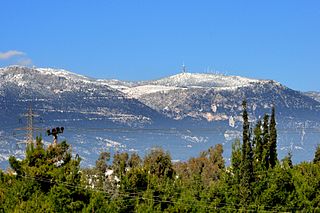
Mount Parnitha is a densely forested mountain range north of Athens, the highest on the peninsula of Attica, with an elevation of 1,413 m, and a summit known as Karavola (Καραβόλα). Much of the mountain is designated a national park, and is a protected habitat for wildfowl, first created in 1961. The summit is located 18 km north of Acharnes and about 30 km north of Athens city center, while the mountain covers approximately 250 km² of land. Other peaks include Mavrovouni (Μαυροβούνι), Ornio, Area, Avgo or Avgho, and Xerovouni. It also has two shelters Mpafi and Flampouri. The name of the mountain dates back to ancient times, when it was under the ancient demes of Acharnae and Decelea.

Mount Pentelicus or Pentelikon is a mountain in Attica, Greece, situated northeast of Athens and southwest of Marathon. Its highest point is the peak Pyrgari, with an elevation of 1,109 m. The mountain is covered in large part with forest, and can be seen from southern Athens (Attica), the Pedia plain, Parnitha, and the southern part of the northern suburbs of Athens. Houses surround the mountain, especially in Vrilissia, Penteli, Ekali, Dionysos and north of Gerakas. Marble from Mount Pentelicus is of exceptionally high quality and was used to construct much of the Athenian Acropolis. Later, Pentelic marble was exported to Rome, where it was used in construction and in sculptures.

Vrilissia is a suburban municipality of the North Athens regional unit, in the Attica region. It is located in the Athens basin, at the southwestern foot of the Penteli Mountain. At the 2011 census, the municipality had 30,741 residents.

The Black Friday bushfires of 13 January 1939, in Victoria, Australia, were part of the devastating 1938–1939 bushfire season in Australia, which saw bushfires burning for the whole summer, and ash falling as far away as New Zealand. It was calculated that three-quarters of the State of Victoria was directly or indirectly affected by the disaster, while other Australian states and the Australian Capital Territory were also badly hit by fires and extreme heat. As of 3 November 2011, the event was one of the worst recorded bushfires in Australia, and the third most deadly.
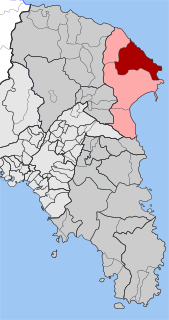
Grammatiko is a village in East Attica, Greece. Since the 2011 local government reform it is part of the municipality Marathon, of which it is a municipal unit. It is part of Athens metropolitan area.

Varnavas is a town in East Attica, Greece. Since the 2011 local government reform it is part of the municipality Marathon, of which it is a municipal unit. It is part of Athens metropolitan area.
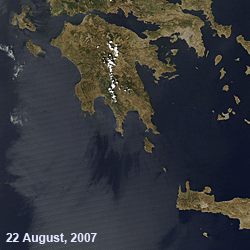
The 2007 Greek forest fires were a series of massive forest fires that broke out in several areas across Greece throughout the summer of 2007. The most destructive and lethal infernos broke out on 23 August, expanded rapidly and raged out of control until 27 August, until they were finally put out in early September. The fires mainly affected western and southern Peloponnese as well as southern Euboea. The death toll in August alone stood at 67 people. In total 84 people lost their lives because of the fires, including several fire fighters.

Forestry in India is a significant rural industry and a major environmental resource. India is one of the ten most forest-rich countries of the world. Together, India and 9 other countries account for 67 percent of total forest area of the world. India's forest cover grew at 0.20% annually over 1990–2000, and has grown at the rate of 0.7% per year over 2000–2010, after decades where forest degradation was a matter of serious concern.

Skai Group is one of the largest private media groups in Greece owned by Eidiseis Dot Com Anonymi Radiotileoptiki-Emporiki Etairia Parohis Pliroforion-Enimerosis. It consists of one television station, three radio stations, one news web portal and one publishing house. The media group is connected with "I KATHIMERINI" S.A. which publishes the Greek newspaper Kathimerini.

Deforestation in Borneo has taken place on an industrial scale since the 1960s. Borneo, the third largest island in the world, divided between Indonesia, Malaysia and Brunei, was once covered by dense tropical and subtropical rainforests.
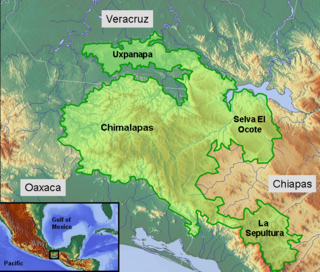
The Selva Zoque, which includes the Chimalapas rain forest, is an area of great ecological importance in Mexico. Most of the forest lies in the state of Oaxaca but parts are in Chiapas and Veracruz. It is the largest tract of tropical rainforest in Mexico, and contains the majority of terrestrial biodiversity in the country. The forest includes the Selva El Ocote, a federally-protected biosphere reserve, but is otherwise not yet protected. Despite the rich ecology of the region, a 2003 study that focused on bird populations stated that "the fauna of the heart of the Chimalapas, including its vast rainforests, have seen little or no study". As it is an impoverished region, efforts to preserve the ecology are often at odds with demands to improve the economy.

The forests of Kosovo make up about 41% of the entire surface of the territory. Most of the forests are located in southwestern Kosovo, including the outskirts of Peja, Deçan, Istok, Junik and Gjakova and are protected by particular laws of the Kosovan Constitution. There are several types of forests in Kosovo and they are mostly represented by pinnate ones.
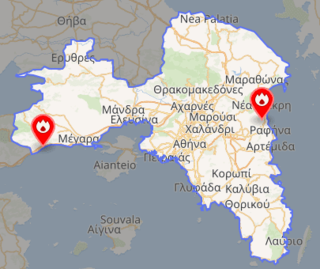
A series of wildfires in Greece, during the 2018 European heat wave, began in the coastal areas of Attica in July 2018. 104 people were confirmed dead from the Mati fires. The fires were the second-deadliest wildfire event in the 21st century, after the 2009 Black Saturday bushfires in Australia that killed 173.

The 2019 Alberta wildfires have been described by NASA as part of an extreme fire season in the province. In 2019 there were a total of 803,393.32 hectares, which is over 3.5 times more land area burned than in the five-year average burned. The five year average is 747 fires destroying 146,360.08 hectares. There were 644 wildfires recorded in Alberta. By May 31, 10,000 people had been evacuated, 16 homes, and the Steen River CN railway bridge, had been destroyed.

The 2021 Greece wildfires were multiple wildfires in Greece in August 2021, which killed 3 people, injured at least 20 others and burned dozens of homes, after a historic heatwave for the country, with the highest temperatures reaching 47.1 °C (116.8 °F). Authorities evacuated several villages and towns. According to BBC News, Greece experienced the worst heatwave since 1987. These fires were the worst fires in Greece since the 2007 Greek forest fires which burnt more than double the area of the 2021 fires.

Storm Ballos was a notable extratropical cyclone that caused devastating floods across Greece during mid-October 2021. The second storm to be officially named in conjunction with the naming list of the former, Israel and Cyprus, Ballos formed on 13 October over the Mediterranean Sea from the combination of a frontal system and a circulation which first developed, two days earlier. It then moved over Greece, before proceeding into the Aegean Sea, where it slowly weakened and dissipated by 16 October. However, despite the HNMC naming the system, the Free University of Berlin (FUB) didn’t assign any name on it along with its weather maps.





















